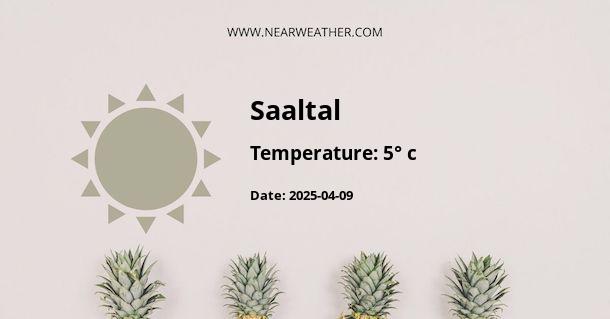Saaltal, Germany: Climate and Weather Year Round
Saaltal, located in Germany, is a picturesque region known for its natural beauty and diverse climate. Situated in the heart of Europe, Saaltal experiences a temperate climate with distinct seasons throughout the year. In this article, we will explore the climate and weather patterns that shape Saaltal, providing detailed information on temperature, precipitation, and other meteorological factors.
Temperature
The temperature in Saaltal varies significantly throughout the year, with warm summers and cold winters. The region experiences an average annual temperature of around 10 degrees Celsius (50 degrees Fahrenheit).
During the summer months of June, July, and August, temperatures in Saaltal can reach an average high of 25 degrees Celsius (77 degrees Fahrenheit). However, heatwaves can occasionally push temperatures above 30 degrees Celsius (86 degrees Fahrenheit), providing ideal conditions for outdoor activities and exploration of the region's natural attractions.
On the other hand, winters in Saaltal are cold, with temperatures often dropping below freezing. The months of December, January, and February experience average lows of -5 degrees Celsius (23 degrees Fahrenheit). Snowfall is common during this time, creating a winter wonderland that attracts visitors from all over.
Precipitation
Saaltal receives a moderate amount of precipitation throughout the year, with rain being the most common type. The region experiences an average annual rainfall of around 700 millimeters (27.5 inches).
Spring and summer are the wettest seasons in Saaltal, with the months of May, June, and July receiving the highest amount of rainfall. Thunderstorms are also frequent during this time, adding to the overall precipitation levels. It is important to note that heavy rainfall can occasionally lead to localized flooding in low-lying areas.
Autumn and winter, on the other hand, are relatively drier compared to the rest of the year. However, snowfall during the winter months can contribute to the overall precipitation levels. The months of November, December, and January receive the highest amount of snowfall, creating a picturesque winter landscape.
Sunshine
Saaltal enjoys a moderate amount of sunshine throughout the year, with longer daylight hours during the summer months. On average, the region receives around 1,600 hours of sunshine annually.
The summer months of June and July experience the highest amount of sunshine, with an average of 8 to 9 hours per day. This provides ample opportunity for outdoor activities such as hiking, biking, and exploring the region's natural wonders.
During the winter months, however, sunshine hours are significantly reduced. December and January have the shortest daylight hours, with only 2 to 3 hours of sunshine per day. This can be attributed to the higher latitude and shorter days during the winter solstice.
Wind
The Saaltal region experiences moderate wind speeds throughout the year. The prevailing winds in the area are influenced by its geographical location and surrounding topography.
During the summer months, gentle breezes are common, providing a pleasant atmosphere for outdoor activities. However, occasional gusts of wind can occur during thunderstorms.
In contrast, winter months can bring stronger and colder winds, especially from the north and northeast. These winds can contribute to the lower temperatures and wind chill factor, making winter activities a unique experience in Saaltal.
Climate Variability
The climate in Saaltal, like many other regions, is subject to natural fluctuations and long-term climate change. It is important to consider the potential impacts of climate change on the region's weather patterns.
According to climate models, Saaltal is expected to experience warmer temperatures and changes in precipitation patterns in the coming decades. This could potentially lead to more extreme weather events, including heatwaves and heavy rainfall.
It is crucial for the region to adapt to these changes and implement sustainable practices to mitigate the impacts of climate change. This includes initiatives such as reducing greenhouse gas emissions, promoting renewable energy sources, and implementing effective water management strategies.
Conclusion
Saaltal, Germany, offers a diverse climate with distinct seasons that attract visitors throughout the year. From warm summers to cold winters, the region provides a range of weather conditions for various outdoor activities and exploration. It is important to consider the climate variability and potential impacts of climate change in order to ensure the sustainability and resilience of Saaltal's environment.
A - Saaltal's Latitude is 50.622398 & Longitude is 11.508560.
A - Weather in Saaltal is 5° today.
A - Climate Conditions in Saaltal shows clear sky today.
A - Humidity in Saaltal is 78% today.
A - Wind speed in Saaltal is 2.88 km/h, flowing at 207° wind direction. today.
